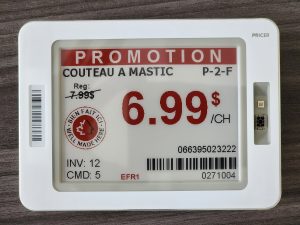The Shift in Consumer Habits
The current and ongoing threat of tariffs between the USA and Canada has led to a significant cultural shift in the buying habits of consumers. With growing economic tensions, Canadian consumers are making a conscious effort to support local businesses and products. This shift is not just a reaction to economic policies but also a reflection of national pride, as more consumers actively seek out Canadian-made goods.
Retailers Identifying Locally Made Products
As consumer preferences evolve, retailers are working to identify and promote Canadian-made products more effectively within their stores. To address this need, JRTech Solutions and the non-profit organization  Well-Made-Here/Bien-Fait-Ici have partnered to integrate the Well-Made-Here/Bien-Fait-Ici certification into JRTech’s electronic shelf labels (ESLs) in hardware stores across Canada. This initiative ensures that products meeting the organization’s criteria are clearly marked, making it easier for shoppers to identify and choose locally produced goods which comply with Canadian building codes and standards (source).
Well-Made-Here/Bien-Fait-Ici have partnered to integrate the Well-Made-Here/Bien-Fait-Ici certification into JRTech’s electronic shelf labels (ESLs) in hardware stores across Canada. This initiative ensures that products meeting the organization’s criteria are clearly marked, making it easier for shoppers to identify and choose locally produced goods which comply with Canadian building codes and standards (source).
Similarly, Laferté Hardware was the first Hardware store to leverage JRTech Solutions’ ESLs to highlight Quebec-made products with a fleur-de-lis icon and Canadian-made products with a maple leaf icon. These dynamic labels provide a seamless way for retailers to support and promote domestic goods while aligning with consumer demand.
Tariff Identification on Store Labels
Recently, Loblaws, a major Canadian supermarket chain announced a new initiative to help customers navigate the impact of tariffs. The retailer is incorporating a “T” symbol on price labels to indicate products that have increased in cost due to tariffs (source). This move echoes the importance of transparency in pricing, allowing consumers to make more informed purchasing decisions in response to external economic pressures.
The Role of ESLs During Crisis Periods
The COVID-19 pandemic provided a clear demonstration of the importance of adaptable pricing technology in retail during challenging times. During the pandemic, retailers faced an exponential increase in supplier-driven price changes, often with fewer employees available to manually update pricing. JRTech Solutions’ ESLs allowed retailers to instantly update prices across stores with minimal effort, ensuring accuracy and operational efficiency. This was a welcome relief to retailers who were burdened by doing more with less staff while also implementing COVID-related health measures within their stores. Following the pandemic, JRTech conducted a study to assess retailers’ perceptions of ESLs after having dealt with the first wave of the pandemic. The findings revealed that 92% of retailers viewed electronic shelf labels as essential to their operations, particularly in addressing challenges imposed by crises like COVID-19.
ESLs: A Solution for Price Volatility and Trade Uncertainty
Today, the ongoing trade tensions between the U.S. and Canada present new challenges for both retailers and consumers on both sides of the border. Fluctuating currency values and tariff-related price increases create uncertainty, making it more difficult for retailers to maintain stable pricing strategies. ESL technology provides a powerful solution by allowing stores to dynamically adjust prices in response to economic changes while simultaneously identifying product provenance through national symbols or tariff indicators.
This real-time adaptability of electronic shelf labels ensures that customers are always informed about pricing changes while enabling retailers to remain competitive in an unpredictable economic climate.
ESLs are proving to be more than just pricing tools; they are becoming critical assets for retail adaptability. Whether addressing shifts in consumer preference, responding to supply chain disruptions, or navigating international trade tensions, ESLs provide retailers with the agility they need to stay ahead. By embracing this technology, retailers can not only meet evolving market demands but also prepare for unforeseen challenges in an increasingly unpredictable future.
As the retail landscape continues to evolve, businesses must evaluate how ESLs can enhance their operations—not just for current market conditions but for whatever challenges may arise next.

